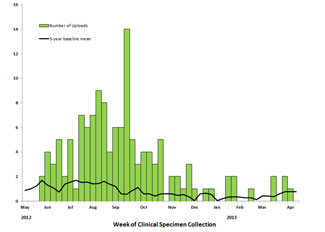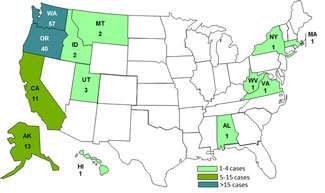July 10, 2013
Final Case Count Update
A total of 134 individuals infected with the outbreak strain of Salmonella Heidelberg were reported from 13 states. Since the last update, six new ill persons were reported from Alaska (2), California (2), Oregon (1), and Washington (1).
Among 134 persons for whom information was available, illness onset dates ranged from June 4, 2012 to April 16, 2013. Ill persons ranged in age from less than 1 year to 94 years, with a median age of 22 years. Fifty-five percent of ill persons were female. Among 105 persons with available information, 33 (31%) were hospitalized, and no deaths were reported.
March 5, 2013
Case Count Update
Since June 4, 2012, a total of 128 individuals infected with the outbreak strain of Salmonella Heidelberg have been reported from 13 states. The number of ill persons identified in each state with the outbreak strain is as follows: Alabama (1), Alaska (11), California (9), Hawaii (1), Idaho (2), Massachusetts (1), Montana (2), New York (1), Oregon (39), Utah (3), Virginia (1), Washington (56), and West Virginia (1). Since the last update, four new ill persons have been reported from Alabama (1), California (2), and Oregon (1).
Among 128 persons for whom information is available, illness onset dates range from June 4, 2012 to February 4, 2013. Ill persons range in age from less than 1 year to 94 years, with a median age of 22 years. Fifty-five percent of ill persons are female. Among 103 persons with available information, 32 (31%) reported being hospitalized. No deaths have been reported.
Clinical specimens collected after February 4, 2013 might not yet be reported yet due to the time it takes between when a person becomes ill and when the illness is reported.
Investigation Update
Testing conducted by the Washington State Public Health Laboratories identified the outbreak strain of Salmonella Heidelberg in four intact samples of chicken collected from three ill persons’ homes in Washington.
The National Antimicrobial Resistance Monitoring System (NARMS) retail meat surveillance program is an ongoing collaboration among the U.S. Food and Drug Association Center for Veterinary Medicine, CDC, and participating state public health laboratories. NARMS monitors antimicrobial resistance in Salmonella, Campylobacter, Enterococcus, and Escherichia coli isolated from raw unprocessed retail meats. From 2002 to 2011, Salmonella was isolated from 1503 (13%) of 11417 retail chicken samples tested by NARMS. Salmonella Heidelberg was identified in 233 retail chicken samples tested by 11 state public health laboratories. Among these 233 isolates, 48 (21%) matched the outbreak strain, and 47 (98%) of those were isolated from Foster Farms retail chicken samples.
Additionally, NARMS at CDC conducted antimicrobial susceptibility testing on isolates collected from 14 ill persons infected with the outbreak strain and isolates from the four intact samples of chicken taken from ill persons’ homes. Twelve of fourteen isolates from ill persons were susceptible to all antibiotics tested, but two were resistant to multiple antibiotics, including amoxicillin/clavulanic acid, ampicillin, and ceftriaxone. Ceftriaxone is commonly used to treat invasive Salmonella infections and is particularly important for treating such infections in children. Three of the four isolates from chicken samples were susceptible to all antibiotics tested, but one was resistant to gentamicin, streptomycin, and sulfisoxazole. Individuals infected with antibiotic-resistant Salmonella may not respond to treatment or may have more severe infections than those infected with susceptible strains.
Initial Announcement
February 14, 2013
CDC is collaborating with public health officials in many states and the U.S. Department of Agriculture’s Food Safety and Inspection Service (USDA-FSIS) to investigate a multistate outbreak of Salmonella Heidelberg infections. Public health investigators are using DNA “fingerprints” of Salmonella bacteria obtained through diagnostic testing with pulsed-field gel electrophoresis, or PFGE, to identify cases of illness that may be part of this outbreak. They are using data from PulseNet, the national subtyping network made up of state and local public health laboratories and federal food regulatory laboratories that performs molecular surveillance of foodborne infections.
Since June 4, 2012, a total of 124 individuals infected with the outbreak strain of Salmonella Heidelberg have been reported from 12 states. Most of the ill persons have been reported from two states, Washington (56) and Oregon (38). At this time, CDC is not releasing the names of the other states until it is determined how these illnesses are linked to this outbreak.
Among 124 persons for whom information is available, illness onset dates range from June 4, 2012, to January 6, 2013. Ill persons range in age from less than 1 year to 94 years, with a median age of 23 years. Fifty-five percent of ill persons are female. Among 97 persons with available information, 31 (32%) reported being hospitalized. No deaths have been reported. Ill persons continue to be reported at lower levels in the most recent months, which may represent a “winter lull” in Salmonella infections.
The outbreak can be visually described with a chart showing the number of people who became ill each day or week. This chart is called an epi curve. Illnesses that occurred after January 6, 2013 might not be reported yet due to the time it takes between when a person becomes ill and when the illness is reported. This takes an average of 2 to 3 weeks. For more details, please see Salmonella Outbreak Investigations: Timeline for Reporting Cases.
Investigation of the Outbreak
Epidemiologic and traceback investigations conducted by officials in local, state, and federal public health, agriculture, and regulatory agencies indicate that consumption of chicken is the most likely source of this outbreak of Salmonella Heidelberg infections. Washington and Oregon have identified Foster Farms brand chicken as the most likely source of the infections in their states. Approximately 81% of ill persons interviewed report consuming chicken in the week before becoming ill. Investigations are ongoing to determine the specific type and source of chicken that might be linked with illness.
FSIS is currently conducting an investigation to determine the source of infections in this outbreak. CDC and state and local public health partners are continuing laboratory surveillance through PulseNet to identify additional ill persons and to interview ill persons about foods eaten before becoming ill. FSIS is continuing to work closely with CDC and state partners during this investigation.

